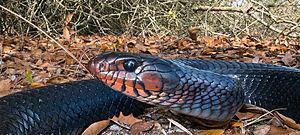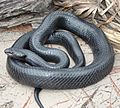Eastern indigo snake facts for kids
Quick facts for kids Eastern indigo snake |
|
|---|---|
 |
|
| Conservation status | |
| Scientific classification | |
| Genus: |
Drymarchon
|
| Species: |
couperi
|
 |
|
| Synonyms | |
|
|
The eastern indigo snake (Drymarchon couperi) is a very large, non-venomous snake. It belongs to the family called Colubridae. This amazing snake lives in the southeastern United States. It is actually the longest snake species native to the country!
Contents
About the Eastern Indigo Snake
What's in a Name?
The eastern indigo snake was first described by John Edwards Holbrook in 1842. For many years, scientists thought there was only one type of Drymarchon snake. But in the 1990s, they decided the eastern indigo snake was its own unique species.
The name Drymarchon means "lord of the forest." It comes from two old Greek words. Drymos means "forest," and archon means "lord" or "ruler."
The second part of its scientific name, couperi, honors American planter James Hamilton Couper. He helped Holbrook find the first snake specimen in Georgia.
Other Names for the Snake
People call the eastern indigo snake by many different names. Some common names include indigo snake, blue indigo snake, and black snake. You might also hear it called blue gopher snake or blue bull snake.
Appearance and Size
The eastern indigo snake has smooth, shiny scales that are a uniform blue-black color. In bright light, its scales can look purplish. Some snakes might have a reddish-orange or tan color on their throat and chin.
This snake is known for being the longest native snake in the United States. The longest one ever found was about 2.8 m (9.2 ft) long. That's longer than a small car!
Male indigo snakes are usually a bit bigger than females. A typical adult male is about 1.2–2.36 m (3.9–7.7 ft) long. They weigh between 0.72–4.5 kg (1.6–9.9 lb). Females are a bit smaller, usually around 1.1–2 m (3.6–6.6 ft) long. They weigh about 0.55–2.7 kg (1.2–6.0 lb).
Where They Live
The eastern indigo snake lives in the southeastern United States. You can find them from southwestern South Carolina all the way through Florida. They also live west into southern Alabama and southeastern Mississippi. Long ago, they used to live in Louisiana too.
A close relative, the Texas indigo snake, lives in southern Texas and Mexico.
Conservation Status
The eastern indigo snake is a federally threatened species in Georgia and Florida. This means their numbers are low, mainly because they are losing their homes. In Alabama, they were once thought to be gone from the state. But a program to bring them back has shown good results! A snake was seen there in 2022.
A big effort is underway in northern Florida to help these snakes. In 2017, 12 snakes were released at a special preserve. More snakes have been released since then. This project helps bring the eastern indigo snake back to areas where it used to live.
Another problem for these snakes is a fungus called snake fungal disease. This fungus can cause skin problems, especially on their heads.
Preferred Habitat
Eastern indigo snakes like many different types of places. They live in flatwoods, forests, and areas with sandy soils. In Georgia, they especially like sandy areas near streams.
During colder months, they often use burrows made by gopher tortoises (Gopherus polyphemus). These burrows are like safe houses. They protect the snakes from predators, fires, and very hot or cold weather.
The snakes change where they live depending on the season. From December to April, they prefer sandy hills. In summer, they move to different areas. From August to November, they often stay in shady creek bottoms.
Cover and Shelter Needs
Eastern indigo snakes need different types of shelter throughout the year. It's important to keep areas connected so they can move between habitats. In spring and fall, they travel from sandy hills to creek bottoms.
In winter, they need gopher tortoise burrows to stay safe. These burrows are usually in open pine forests. The burrows must be in places that don't flood. The snakes also use piles of wood and debris for hiding. These piles are very important for the snakes and their prey.
Food and Behavior
The eastern indigo snake is a carnivorous animal, meaning it eats meat. Like all snakes, it eats any small animal it can catch. It sometimes presses its prey against burrow walls to kill it.
Its diet includes other snakes, even venomous ones! The eastern indigo snake is immune to the venom of North American rattlesnakes. They also eat turtles, lizards, frogs, toads, fish, small birds, mammals, and eggs.
When scared, the eastern indigo snake might flatten its neck, hiss, and vibrate its tail. But if you pick one up, it usually won't bite.
These snakes often share burrows with gopher tortoises. If they can't find a tortoise burrow, they might use armadillo holes, hollow logs, or piles of debris. Sadly, some people harm these snakes when they try to find rattlesnakes. They might pour gasoline into burrows, which is illegal and hurts protected animals like the gopher tortoise and the indigo snake.
Predators and Threats
Eastern indigo snakes are at the top of their food chain. They don't have natural predators. The biggest threat to them is humans.
Many snakes are killed by cars on highways. Some are killed on purpose. Also, people sometimes illegally take these snakes from the wild to sell as pets. This harms their populations.
The loss of their habitat is a huge problem. As their homes are destroyed or broken up, it's harder for them to survive. Since they rely on gopher tortoise burrows, the decline of gopher tortoises also hurts the indigo snake.
Reproduction and Life Cycle
Eastern indigo snakes lay eggs. The eggs are about 75–100 mm (3–4 in) long. Females lay one group of 4 to 14 eggs. This usually happens from late April to early June.
When they hatch, the baby snakes are about 600–700 mm (23+1⁄2–27+1⁄2 in) long. Eastern indigo snakes grow slowly. They usually don't become adults until they are 3 to 5 years old. At that age, they are about 5 to 6 feet long.
Female indigo snakes can store sperm for a very long time, sometimes over 4 years! This means they can choose the best time to fertilize their eggs. Mating season is usually from November to January.
Keeping Them as Pets
Some people want to keep eastern indigo snakes as pets because they are usually calm. However, because they are a protected species, it can be illegal to own one without a special permit.
In the United States, you need a federal permit to buy one from another state. This permit costs $100. Most states allow you to buy them within the state without extra permits. These snakes need a very large enclosure to live happily in captivity. They also like things to climb on.
Images for kids






